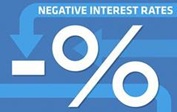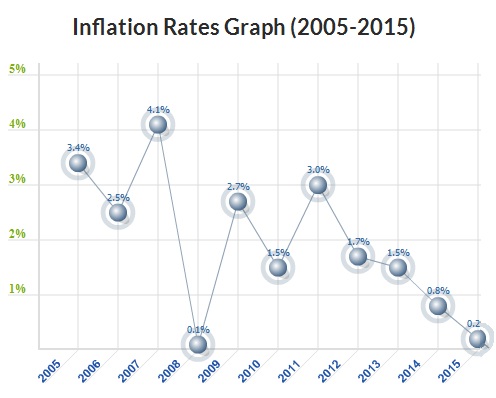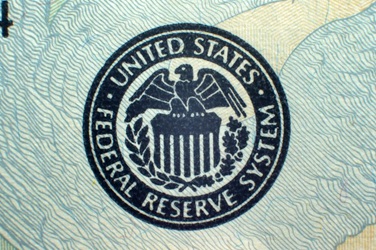Why the FED Needs to Go Negative on Interest Rates?
 Inflation rate in the U.S. is hovering near the zero percent level for the past year. The PECEPI (Personal Consumption Expenditure Price Index) has stayed well below the FED's 2% target rate since March 2012.
Inflation rate in the U.S. is hovering near the zero percent level for the past year. The PECEPI (Personal Consumption Expenditure Price Index) has stayed well below the FED's 2% target rate since March 2012.
A stronger dollar and the falling oil price in the international market has many economists forecasting that the low level inflation rate will continue for a few years, which would amplify present deflationary trends and even threaten the fragile economy of the US.

In Japan and many European countries - Poland, Croatia, Bulgaria, Greece, Sweden, and Spain -, prices have been falling steadily the past few years. This is causing many problems for the policy makers as they look for ways to diffuse the negative effects of deflation such as falling corporate income, dwindling wages, reduced tax revenues, and other problems.
Although the US economy has not yet entered into disinflationary stage, sustained low-level deflation in the US remains a possibility. This is despite the fact that the FED has kept the rates at near zero for nearly a decade.
At present, deflationary trends are decidedly less pronounced in the US as compared to the rest of the developing world. But, the question is what will the Fed do if the economy does enter into a deflationary phase?
 One way the FEDs can combat deflationary trends in the US is through what economists call a Negative Interest Rate Policy (NIRP).
One way the FEDs can combat deflationary trends in the US is through what economists call a Negative Interest Rate Policy (NIRP).
The FED chairman, Janet Yellen, has so far rejected the idea of using the negative interest rate policy to spur the economy and defeat deflation in the US. But this doesn't imply that such a move is completely off the table.
In fact, the FED needs to use this policy if and when inflation rate in the US turns negative in order to curb the menace of deflation. Investors need to be aware of the logic behind NIRP, and most importantly, how it will affect their portfolio in case the FED decides to implement the policy to ramp up the economy.
Negative Interest Rate Policy (NIRP): An Overview
A Negative Interest Rate Policy (NIRP) is a stimulus measure used by the central bank, whereby the nominal interest rates are set with a negative value. The central banks use this policy to spur lending and boost consumption activity. The NIRP policy is an unconventional monetary policy that manipulates tradeoff between reserves and loans. The aim of this policy is to discourage banks from leaving the reserves idle held at the Federal Reserve.
Businesses and individuals tend to stack the money instead of investing during deflationary periods. This results in decreased demand of goods and services, slowdown in economic output, and increase in unemployment that leads to further decrease in prices.
Central banks can use expansionary monetary policy by cutting the rates to near zero to spruce up the economy. However, the conventional policy that is being used at the present by the FED won't work if the deflationary forces have gained momentum.
The FED needs to go negative on interest rate to encourage borrowing and spending. Setting a negative interest rate will force private banks to charge customers for holding their deposits, instead of crediting their account for holding their money. This will provide incentive to businesses and individuals to invest, spend, and lend money instead of keeping it safe in the bank account.
The Swiss government has successfully implemented the NIRP in the early 1970s to counter the appreciation of the currency as investors were hedging their positions in other parts of the world by purchasing Swiss Franc.
Sweden and Denmark had also used the NIRP in 2010 and 2012 respectively to prevent influx of money into their economies. Most recently, the ECB (European Central Bank) instituted the NIRP in 2014 to prevent countries in the Europe region from facing a deflationary cycle.
In theory, targeting the negative interest rates will reduce borrowing costs for the companies and individuals. This will result in increased demand for loans and ramp up business investment activity and consumer spending.
Until now, the FED has stayed away from manipulating interest rates to boost economic activity and inflation levels. Instead, they have chosen to implement a long term QE (quantitative easing) to reduce interest rates through infusing bank investment portfolios with cash rather than government securities.
However, the QE program ended last year in October. And it did not boost inflation rate as projected by the FED. In fact, the QE program that lasted for nearly two years resulted in virtually no increase in the inflation rates.
Due to ineffectiveness of the QE program in increasing inflation rates to targeted levels, as well as the FED's commitment to end the program, investors should expect the FED to use the NIRP as a tool to combat deflationary pressures.
How Will this Affect the Investors Portfolio?
Many economists have predicted that the inflation level will decelerate in the coming months. If the downward spiral continues, the US economy may well enter into a deflationary phase. The interest rates are already set at a near zero level. So, the FED may well consider setting negative interest rate to combat the deflationary trends.
But a big question is; how will this affect the individual investors?
For investors, the negative interest rates could mean many things. On the one hand, the negative interest rates would indicate that the FED is concerned about the economy. Financial institutions and professional investors that closely watch the press conferences and the meeting minutes of the FED will most likely pull out the investment in short term speculative instruments in the hope of avoiding any catastrophe that the FED is trying to stave off.
On the other hand, the negative interest rates could also express the commitment of the FED in providing stimulus to the economy. The announcement of QE had boded well for the market in the past as the program amounted to nothing less than injecting liquidity in the market.
The negative interest rate policy will also have the same effect of strengthening investor's confidence in the FED commitment to the cheap money policy for as long as it takes for the economy to enter into stable inflationary period.
Closing Remarks!
The possibility that the Feds may use negative interest rate policy (NRIP) to combat looming deflationary trends is definitely present. Investors cannot afford to be in the dark when the Fed does implement this drastic measure to ward off deflation, and its negative consequences on the economy. Implementation of negative interest rate policy will require investors to shift their focus and consider the implication on their portfolio.
While the negative rates is imposed by the Feds on commercial banks and not on consumer's saving and checking accounts, the banks will undoubtedly transfer the increase cost of holding the deposits to the end customers. As a result investors should be prepared to devise strategies to protect their saving wealth by investing in lucrative yet safe investment avenues.
Currently, short-term treasury securities in the US are already trading with negative yields (interest rates). At present, the yield on 1-month bill is in negative territory at -0.02% while the 3-months bills have a zero yield. An investor that holds these short-term treasury bills will log a capital loss. Moreover, although, the yield on long-term treasury securities is positive, it is hovering at a very low level at the moment. If the FED implements negative interest rate policy, the rates on both short and long term treasury bills will fall deeper into the negative zone.
The potential I see is the jump in bond values (not yield) during the first half of the bear market (6-12 months from now), then I feel you will want to be invested in equities again and/or real estate but depending on the market conditions at that time things will need to be re-evaluated.
Learn more and profit from the financial uncertainty with me at:
www.TheGoldAndOilGuy.com - Join Now & Save $198
Chris Vermeulen
















